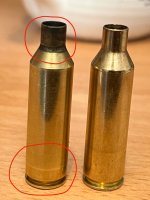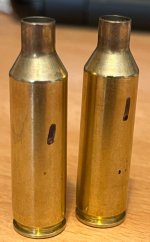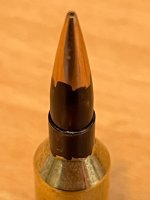stagpanther
New member
I built a 25 PRC blackjack a few years ago based on a savage 110 long action but have had inconsistent results (and then the collapse of the blackjack altogether taking my unfulfilled and paid bullet order with it). The barrel was custom made and chamber reamed by a prominent company that shall go nameless.
I did what many others did at the time since there were no dies being made for it--simply took a redding 6.5 PRC bushing die and got a set of .257 bushings to dial in the appropriate neck tension and neck diameter and then sized factory 6.5 brass. No turning was necessary and the process was pretty straight-forward. First firing was generally OK and I was getting 5 shot groups in the .75 MOA range in the 150 to 200 yd range--nice, but nothing to write home about in contrast to its sensational reputation (yeah, the latest boy-wonder phenomenon).
I never did much shooting with it after other interests dragged my attention, but did notice after a few firings of the sized brass that pierced primers started appearing even with low-powered loads. I took the rifle apart and redid the headspacing with PTG's go no/go guages (sans ejector and extractor in the bolt head) and got a solid stop with no go after setting the go and retightened the barrel nut and put the rifle back together. Firing the cartridges I'm still getting pierced primers on low pressure loads; so now I'm think I might have a long headspace issue resulting in the brass slamming back into the bolt face upon firing. I check with the no-go guage and it gets a solid stop as before--but measuring fired vs unfired factory 6.5 brass I'm getting about .007 elongation in the case as measured on the shoulder. Furthermore, as you can see from the photo below (fired resized 25 PRC on the left, unfired factory 6.5 PRC on the right), I'm getting noticeable flow/expansion from the case head which probably is weakening the brass and inviting a blow-out sooner or later.
This is a stumper that I haven't encountered before on my savage builds--but just out of curiosity I took a factory fresh 6.5 PRC cartridge (I don't have any stand-alone factory brass), pulled the bullet and inserted it into my rifle--it chambered just fine with no resistance. There's only a .002 OD of the neck difference between the unfired 6.5 brass and that of my 25 sized brass.
Looking at the neck/shoulder junction which has a ring and obvious gas leak signs it looks to me like the neck is expanding up and out upon firing and possibly the case is recoiling back into the bolt face while at the same time elongating out case/shoulder length.
What do you think? (yes, I figure the next step is to pull the barrel and do a cast, but is my theory way off base?).

I did what many others did at the time since there were no dies being made for it--simply took a redding 6.5 PRC bushing die and got a set of .257 bushings to dial in the appropriate neck tension and neck diameter and then sized factory 6.5 brass. No turning was necessary and the process was pretty straight-forward. First firing was generally OK and I was getting 5 shot groups in the .75 MOA range in the 150 to 200 yd range--nice, but nothing to write home about in contrast to its sensational reputation (yeah, the latest boy-wonder phenomenon).
I never did much shooting with it after other interests dragged my attention, but did notice after a few firings of the sized brass that pierced primers started appearing even with low-powered loads. I took the rifle apart and redid the headspacing with PTG's go no/go guages (sans ejector and extractor in the bolt head) and got a solid stop with no go after setting the go and retightened the barrel nut and put the rifle back together. Firing the cartridges I'm still getting pierced primers on low pressure loads; so now I'm think I might have a long headspace issue resulting in the brass slamming back into the bolt face upon firing. I check with the no-go guage and it gets a solid stop as before--but measuring fired vs unfired factory 6.5 brass I'm getting about .007 elongation in the case as measured on the shoulder. Furthermore, as you can see from the photo below (fired resized 25 PRC on the left, unfired factory 6.5 PRC on the right), I'm getting noticeable flow/expansion from the case head which probably is weakening the brass and inviting a blow-out sooner or later.
This is a stumper that I haven't encountered before on my savage builds--but just out of curiosity I took a factory fresh 6.5 PRC cartridge (I don't have any stand-alone factory brass), pulled the bullet and inserted it into my rifle--it chambered just fine with no resistance. There's only a .002 OD of the neck difference between the unfired 6.5 brass and that of my 25 sized brass.
Looking at the neck/shoulder junction which has a ring and obvious gas leak signs it looks to me like the neck is expanding up and out upon firing and possibly the case is recoiling back into the bolt face while at the same time elongating out case/shoulder length.
What do you think? (yes, I figure the next step is to pull the barrel and do a cast, but is my theory way off base?).
Attachments
Last edited:



